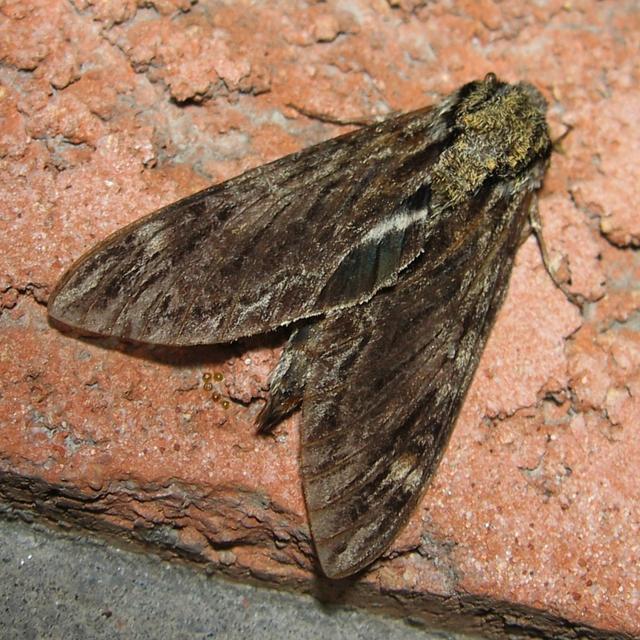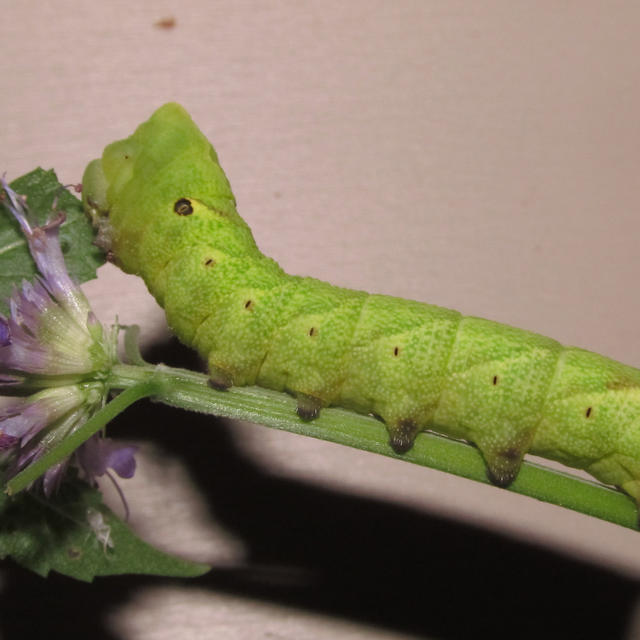Hermit sphinx
Lintneria eremitus (Hübner, 1823)
Family: Sphingidae
Subfamily: Sphinginae
Identification: Forewing is gray-brown with wavy lines, black dashes, and 1 or 2 small white spots near the center of the costa. Hindwing is black with 2 white bands and a triangular black patch at the base.
Wing Span: 2 9/16 - 2 15/16 inches (6.5 - 7.5 cm).
Life History: Fully-grown caterpillars pupate in chambers underground.
Flight: . One brood from July-August.
Caterpillar Hosts: Various species of beebalm (Monarda), mints (Mentha), bugleweed (Lycopis), and sage (Salvia).
Adult Food: Deep-throated flowers including Japanese honeysuckle (Lonicera japonica), bouncing bet (Saponaria officinalis), petunia (Petunia species), and catalpa (Catalpa speciosa).
Habitat:
Range: Maine south to North Carolina, west to Manitoba, South Dakota, and Missouri.
Conservation: Not usually required.
NCGR: G4 - Apparently secure globally, though it might be quite rare in parts of its range, especially at the periphery.
Management Needs: None reported.
Comments: NULL
Taxonomy Notes: Formerly Sphinx eremitus.
Alternate Scientific Names:
Sphinx eremitus
Get your BAMONA Gear!
Please donate!
We depend on donations to keep Butterflies and Moths of North America freely available. We want to express our gratitude to all who showed their support by making a contribution this year. You can donate to support this project at any time.
Advertise with us!
Do you have a product or service that you think would interest BAMONA users? If you would like to advertise on this website, contact us by email, or use the contact form and select the "Advertising" category.
Verified Sightings
Displaying 49 - 72 of 206 verified sightings

Observation date: Jul 13, 2018
Submitted by: Ilona L.
Region: Dane County, Wisconsin, United States
Verified by: Ilona L.
Verified date: Sep 13, 2018

Observation date: Sep 13, 2018
Submitted by: marion mahn
Region: Bergen County, New Jersey, United States
Verified by: curtis.lehman
Verified date: Sep 13, 2018

Observation date: Sep 12, 2018
Submitted by: curtis.lehman (Barbara Martin)
Region: Allegheny County, Pennsylvania, United States
Verified by: curtis.lehman
Verified date: Sep 12, 2018

Observation date: Jul 18, 2018
Submitted by: pabirdermoore
Region: Clarion County, Pennsylvania, United States
Verified by: curtis.lehman
Verified date: Jul 20, 2018

Observation date: Jul 19, 2015
Submitted by: stonehollow
Region: Wright County, Minnesota, United States
Verified by: Tom Middagh
Verified date: Jan 29, 2018

Observation date: Sep 15, 2017
Submitted by: CZACH
Region: Licking County, Ohio, United States
Verified by: rogerdowner
Verified date: Nov 02, 2017

Observation date: Oct 06, 2017
Submitted by: Kellyanncapo
Region: Monroe County, Pennsylvania, United States
Verified by: curtis.lehman
Verified date: Oct 07, 2017

Observation date: Sep 16, 2017
Submitted by: Northrnr
Region: York County, Pennsylvania, United States
Verified by: curtis.lehman
Verified date: Sep 16, 2017

Observation date: Sep 07, 2017
Submitted by: aaldrich
Region: Clarion County, Pennsylvania, United States
Verified by: curtis.lehman
Verified date: Sep 08, 2017

Observation date: Sep 04, 2017
Submitted by: Mkortyna
Region: Clarion County, Pennsylvania, United States
Verified by: curtis.lehman
Verified date: Sep 05, 2017

Observation date: Aug 30, 2017
Submitted by: Kissisgreat23
Region: Hampden County, Massachusetts, United States
Verified by: rogerdowner
Verified date: Aug 31, 2017

Observation date: Aug 15, 2017
Submitted by: woody0511
Region: Chester County, Pennsylvania, United States
Verified by: curtis.lehman
Verified date: Aug 16, 2017

Observation date: Aug 04, 2017
Submitted by: Joe Bartok
Region: Ontario, Canada
Verified by: curtis.lehman
Verified date: Aug 11, 2017

Observation date: Jul 24, 2017
Submitted by: Colin Gillette
Region: Bradford County, Pennsylvania, United States
Verified by: curtis.lehman
Verified date: Jul 24, 2017

Observation date: Jul 20, 2017
Submitted by: Joe Bartok
Region: Ontario, Canada
Verified by: rogerdowner
Verified date: Jul 20, 2017

Observation date: Jul 27, 2016
Submitted by: mothman27
Region: Whitley County, Indiana, United States
Verified by: rogerdowner
Verified date: Jan 11, 2017

Observation date: Sep 13, 2016
Submitted by: Sue Gregoire
Region: Schuyler County, New York, United States
Verified by: Sue Gregoire
Verified date: Nov 11, 2016

Observation date: Oct 18, 2016
Submitted by: tigermoth
Region: Clarke County, Virginia, United States
Verified by: rogerdowner
Verified date: Oct 18, 2016

Observation date: Sep 18, 2016
Submitted by: cmill0wm
Region: Garrett County, Maryland, United States
Verified by: rogerdowner
Verified date: Sep 19, 2016

Observation date: Jul 28, 2016
Submitted by: Betsy Higgins
Region: Franklin County, Massachusetts, United States
Verified by: Lula Field
Verified date: Sep 15, 2016

Observation date: Sep 02, 2016
Submitted by: Kimpi
Region: Marathon County, Wisconsin, United States
Verified by: Tom Middagh
Verified date: Sep 11, 2016

Observation date: Aug 02, 2016
Submitted by: iangardner
Region: Lebanon County, Pennsylvania, United States
Verified by: curtis.lehman
Verified date: Aug 24, 2016

Observation date: Jul 31, 2016
Submitted by: rdhealy1951@aol.com
Region: Hart County, Kentucky, United States
Verified by: rogerdowner
Verified date: Aug 15, 2016

Observation date: Aug 09, 2016
Submitted by: atbarnes
Region: Preston County, West Virginia, United States
Verified by: curtis.lehman
Verified date: Aug 09, 2016
- ‹ previous
- 3 of 9
- next ›









